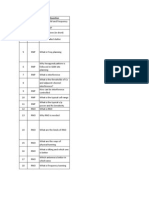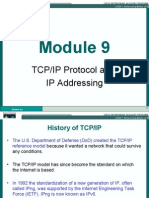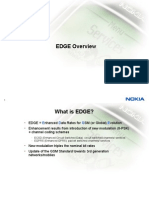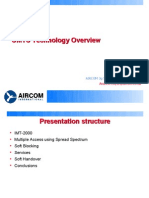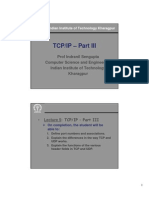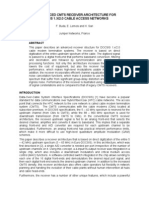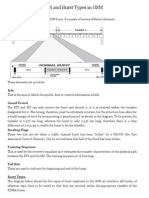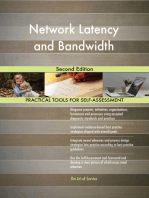LTE Overview Titus
LTE Overview Titus
Uploaded by
Vepur SrikanthCopyright:
Available Formats
LTE Overview Titus
LTE Overview Titus
Uploaded by
Vepur SrikanthOriginal Description:
Copyright
Available Formats
Share this document
Did you find this document useful?
Is this content inappropriate?
Copyright:
Available Formats
LTE Overview Titus
LTE Overview Titus
Uploaded by
Vepur SrikanthCopyright:
Available Formats
1
LTE
LTE
A Technical Overview
A Technical Overview
Titus Lo
tlo@neocific.com
2
Scope of Presentation
Scope of Presentation
Cellular wireless systems
LTE system & architecture
Key Technologies
3
Cellular Wireless Systems
Cellular Wireless Systems
4
Wireless Standard Evolution
Wireless Standard Evolution
IEEE802.16
IEEE802.16
IEEE802.20
IEEE802.20
Analog
AMP
Analog
AMP
1G
GSM
GSM
CDMA
CDMA
TDMA
TDMA
PDC
PDC
2G
GPRS
GPRS
EDGE
EDGE
EDGE-E
EDGE-E
UMTS
UMTS
HSxPA
HSxPA
3G-LTE
3G-LTE
LTE-A
LTE-A
TD-SCDMA
TD-SCDMA
CDMA2000
CDMA2000
EV-DO
EV-DO
EV-DO
Rev-A
EV-DO
Rev-A
EV-DO
Rev-B
EV-DO
Rev-B
EV-DO
Rev-C
EV-DO
Rev-C
2.5G 3G 4G
5
IEEE802
IEEE802
IEEE802.16
IEEE standard that defines a wireless network
on a metropolitan area (WMAN)
Original goal to support fixed and nomadic
users (16a~d)
Evolved to mobility (vehicular speeds) and
increased data rates (16e)
16m under development
IEEE802.20
Span off from 802.16 to support high mobility
applications
For whatever reasons, it lost momentum
Its survival is in doubt
6
3GPP2 Evolution
3GPP2 Evolution
CDMA2000 1X (1999)
CDMA2000 1xEV-DO (2000)
EV-DO Rev. A (2004): VoIP
EV-DO Rev. B (2006): Multi-carrier
Ultra Mobile Broadband (UMB) (a.k.a. EV-DO
Rev. C)
Based on EV-DO, IEEE 802.20, and FLASH-
OFDM
Commercially available in 2009
UMBs fate?
7
3GPP Evolution
3GPP Evolution
Release 99 (Mar. 2000): UTRA in FDD and
TDD (3.84 Mcps) modes
Rel-4 (Mar. 2001): TD-SCDMA
Rel-5 (Mar. 2002): HSDPA with IMS (IP
Multimedia Services)
Rel-6 (Mar. 2005): HSUPA with MBMS
Rel-7 (2007): DL MIMO, optimized real-time
services (VoIP, gaming, push-to-talk)
Rel-8 (Dec. 2008) Long Term Evolution
(LTE)
8
System & Architecture
System & Architecture
9
LTE
LTE
Standardization effort started in late 2004
With HSPA (downlink and uplink), UTRA will remain highly
competitive for several years
IEEE is standardizing mobile WiMAX => Threat for loosing
competitive edge
LTE focus:
Enhancement of the UTRA
Optimisation of the UTRAN architecture
To ensure the continued competitiveness of the 3GPP
technologies for the future
LTE was the first and only technology recognized by
the Next Generation Mobile Network alliance to meet
its broad requirements
Target deployment in 2010
10
Reduced cost per bit
Improve spectrum efficiency ( e.g. 2-4 x Rel6)
Reduce cost of backhaul (transmission in UTRAN)
Increased service provisioning more services at lower cost
with better user experience
Focus on delivery of services utilising IP
Reduced latency, to 10 msec round-trip time between user
equipment and the base station, and to less than 100 msec
transition time from inactive to active
Increase the support of QoS for the various types of services
(e.g. VoIP)
Increase cell edge bit rate whilst maintaining same site
locations as deployed today
Reasonable terminal power consumption
Flexibility of use of existing and new frequency bands
Service Capabilities
Service Capabilities
11
System Capabilities
System Capabilities
Downlink peak data rates up to 326 Mbps with 20
MHz bandwidth
Uplink peak data rates up to 86.4 Mbps with 20 MHz
bandwidth
Operation in both TDD and FDD modes.
Variable duplex technology within bands as well as
between bands
Scalable bandwidth up to 20 MHz, covering 1.4, 2.5,
5, 10, 15, and 20 MHz
Increased spectral efficiency over Release 6 HSPA
by a factor of two to four
Enhance the bit rate for MBMS (e.g. 1-3 Mbps)
12
UTRAN Evolution and UTRA Evolution with
simplified architecture
Open interfaces to support Multi-vendor deployments
Robustness no single point of failure
Support of multi-RAT with resources controlled from
the network
Support of seamless mobility to legacy systems as
well as to other emerging systems including
Inter-RAT Handovers
Service based RAT Selection
Maintain appropriate level of security
Architecture & Mobility
Architecture & Mobility
Capabilities
Capabilities
13
E-UTRAN (LTE)
Evolved Packet System (EPS)
Evolved Packet System (EPS)
eNB
eNB
eNB
eNB
EPC
(Evolved Packet Core)
MME/
S-GW/
P-GW
MME/
S-GW/
P-GW
X2
S1
Other 3GPP
Network
Non-3GPP
Network
AGW (Access Gateway)
MME (Mobility Management
Entity), which manages
mobility, UE identity, and
security parameters
S-GW (Serving Gateway) -
node that terminates the
interface towards E-UTRAN
P-GW (PDN [Packet Data
Network] Gateway) - Node
that terminates the interface
towards PDN
eNB (E-UTRAN NodeB), which
carries out all radio interface-
related functions
14
Functional Split between
Functional Split between
eNB
eNB
& AGW
& AGW
eNB functions
Selection of aGWat attachment;
Routing towards aGWat RRC
activation;
Scheduling and transmission of
paging messages;
Scheduling and transmission of
BCCH information;
Dynamic allocation of resources to
UEs in both uplink and downlink;
The configuration and provision of
eNB measurements;
Radio Bearer Control;
Radio Admission Control;
AGW functions
Paging origination
Ciphering of the user plane
PDCP
SAE Bearer Control
Ciphering and integrity
protection of NAS signaling
15
eNB UE aGW
Control-
plane only
Control-plane
& user-plane
Protocol Stack
Protocol Stack
NAS NAS
RRC RRC
PDCP
RLC
MAC
RLC
MAC
PDCP
PHY PHY
RLC Functions
Transferring upper layer PDUs
Error correction through ARQ
Concatenation, segmentation
and reassembly of RLC SDUs
Re-segmentation of RLC data
PDUs
In sequence delivery of upper
layer PDUs
RLC re-establishment
Protocol error detection and
recovery
PDCP
Header compression and
decompression
Ciphering and deciphering of user
plane data and control plane data
Integrity protection and integrity
verification of control plane data
PHY Functions
Modulation
Coding
Resource mapping
MIMO
RRC functions
Processing of broadcast system information
Paging, which indicates to a device in idle mode that
it might have an incoming call
RRC connection management between the UE and
the eNB
Integrity protection and ciphering of RRC messages
(RRC uses different keys than the user plane)
Radio Bearer control (logical channels at the top of
the PDCP)
Mobility functions (handover & cell reselection)
UE measurement reporting and control of signal
quality
NAS
Functional layer in the UMTS
protocol stack between Core
Network CN and User Equipment
UE
Supporting signaling and traffic
between these two elements
MAC Functions
Mapping between logical channels
and transport channels
Scheduling information reporting
Managing HARQ
Logical channel prioritization;
Transport format selection.
16
Data Flow
Data Flow
17
Channel Mapping
Channel Mapping
Logical channels
Transport channels
Physical channels
Downlink
Uplink
18
Key Technologies
Key Technologies
19
Key Technologies
Key Technologies
OFDMA for DL
SC-FDMA (Single Carrier FDMA) for UL
Bandwidth Flexibility
Advanced antenna technology
Link adaptation
Inter-cell-interference coordination (ICIC)
Two-layered retransmission (ARQ/HARQ)
Multicarrier channel-dependent resource
scheduling
Discontinuous Rx and Tx
MBMS
20
OFDMA
OFDMA
Modulation - OFDM
An OFDM symbol consists of multiple subcarriers of a
certain time duration
Transmitting data over a number of orthogonal
subcarriers
Each subcarrier transports an information symbol
(e.g., QPSK)
Multiple-access scheme
Transmission organized into intervals
Time and frequency resource organized into resource
blocks (RBs)
Multiple RBs assigned to individual users for
transmission
User 1
User 2
User 3
User 4
f
t
21
Time and Frequency Resource
Time and Frequency Resource
Resource element:
subcarrier in an OFDM
symbol
uniquely identified by the
index pair (k,l) in a slot
Resource block
consisting of multiple
RE Physical RB
Normal CP: 12x7
Extended CP: 12x6 (for
15KHz) and 24x3 (for
7.5KHz)
DL
symb
N
slot
T
0 = l 1
DL
symb
= N l
R
B
s
c
D
L
R
B
N
N
R
B
s
c
N
RB
sc
DL
symb
N N
) , ( l k
0 = k
1
RB
sc
DL
RB
= N N k
22
Frame Structure
Frame Structure
Type 1
Twenty time slots in a frame, each 0.5 ms long
A subframe consisting of two slots
Ten subframes for DL and 10 for UL
Type 2
Two half-frames in a frame, each 5 ms long
A half-frame consisting of 5 subframes
A subframe consisting of 2 slots
23
Subframe
Subframe
16.7 for all Extended
5.2 for 1
st
symbol
4.7 for others
Normal
T
cp
(s)
24
DL Physical Channel Processing
DL Physical Channel Processing
modulation of
scrambled bits
to generate
complex-
valued
modulation
symbols
mapping of
the complex-
valued
modulation
symbols onto
one or several
transmission
layers
precoding of
the complex-
valued
modulation
symbols on
each layer for
transmission
on the
antenna ports
mapping of
complex-
valued
modulation
symbols for
each antenna
port to
resource
elements
generation of
complex-
valued time-
domain OFDM
signal for
each antenna
port
scrambling
of coded bits
in each of the
code words
to be
transmitted
on a physical
channel
25
UL Physical Channel Processing
UL Physical Channel Processing
scrambling of
coded bits in
each of the code
words to be
transmitted on a
physical
channel
modulation of
scrambled bits to
generate complex-
valued modulation
symbols
Transform
precoding of the
complex-valued
modulation
symbols to
complex symbols
mapping of
complex-valued
symbols to
resource elements
generation of
complex-valued
time-domain SC-
FDMA signal for
each antenna port
SC-FDMA
DFT
IDFT
Utilizes single carrier modulation and frequency domain equalization
SC-FDMA can be regarded as DFT-precoded or DFT-spread OFDMA
26
SC
SC
-
-
FDMA
FDMA
Two types of SC transmission
Localized transmission
Multi-user scheduling gain in
frequency domain
Need to feedback channel state
information
Mainly for low-to-medium mobility
users
Distributed transmission
Robust transmission for control
channels and high mobility UE
Mainly for high mobility users
M-point
DFT
Spreading
Symbol to
subcarrier
mapping
N-point
IFFT
M M
M
0
0
0
M
M-point
DFT
Spreading
Symbol to
subcarrier
mapping
N-point
IFFT
M M
M
0
0
0
M
0
Localized: contiguous subcarriers
Distributed: evenly spaced subcarriers
27
Bandwidth Flexibility
Bandwidth Flexibility
Supported bandwidths: 1.4, 3.0, 5, 10, 15, 20 MHz
All UE support bandwidth of 110 RBs (110x180 kHz20
MHz)
Fixed subcarrier spacing
Modular sampling rates for different BWs
Adjusting the numbers of RB for different BWs
Fixed symbol length for all BWs
10 MHz 15 MHz 20 MHz 3 MHz 5 MHz 1.4 MHz
30.72 23.04 15.36 7.68 3.84 1.92 Sampling rate (MHz)
2048 1536 1024 512 256 128 IDFT/DFT size
100 75 50 25 15 6 Number of RB per slot
1200 900 600 300 180 72
Number of occupied
subcarriers
15 15 15 15 15 15 Subcarrier spacing (KHz)
20 16 10 6 3 1.4 Channel bandwidth (MHz)
28
DL Synchronization Signals
DL Synchronization Signals
Transmitted on the 72 centre sub-carriers (around DC sub-carrier)
Primary sync signal
carrying 3 unique identities of a cell group
Tx at 1
st
and 5
th
subframes (Type1) or at 2
nd
and 6
th
subframes (Type
2)
Secondary sync signal
carrying 168 cell identity groups
Tx at 1
st
and 5
th
subframes
Generated from Zadoff-Chu sequences
Primary sync signal
Secondary sync signal
PBCH
Type 1
Type 2
6 resource blocks
system bandwidth N
RB
29
DL MIMO Modes
DL MIMO Modes
LTE-MIMO
2x2 and 4x2
Open loop Closed loop
OL Tx
Diversity
OL
Beamforming
Single stream
(Rank 1)
CDD SFBC
Multi-stream
(Rank 2~4)
PARC
Codebook-based
Linear precoding
Single- &
multi-stream
Rank1 : CL TX diversity
Rank 2~4: PSRC
OL single stream
SFBC
Uses diversity by orthogonally
transmitting one data stream over
two transmit antennas
CDD
Uses diversity by transmitting one
data stream over two transmit
antennas at different times
Beamforming
To improve coverage
OL multiple streams
PARC
Uses diversity to transmit
multiple data streams over
multiple transmit antennas
CL
PMI feedback from UE
Codebook-based linear
precoding
PSRC
Uses diversity to transmit
multiple data streams over
multiple transmit antennas
MU-MIMO/SDMA
To improve capacity
Dynamic switching between
spatial multiplexing and
SFBC
30
DL MIMO
DL MIMO
MIMO operation in the frequency domain
Transmitter
Receiver
31
Link adaptation
Link adaptation
Transmission power control
Support fractional path-loss
compensation: UEs close to the cell
border use less tx power
Adaptive modulation and channel
coding rate
Modulation and coding for the shared
data channel adapted according to
Channel Quality Indications (CQI)
reported by UE
Adaptive transmission bandwidth
RB allocation
Low Tx power
At cell edge
64-QAM
16-QAM
QPSK
32
Inter
Inter
-
-
Cell
Cell
-
-
Interference Coordination
Interference Coordination
Allowing frequency reuse >1 at cell edge
UL ICIC
Supported through High-Interference and
Overload Indicators, sent to neighboring cells
Avoiding scheduling UL use at the cell edge in
some parts of the bandwidth
DL ICIC
Restriction of tx power in some parts of the
bandwidth
Coordination supported through RNTP indicator,
sent to neighboring cells
33
ARQ/HARQ
ARQ/HARQ
eNB or UE can to request
retransmissions of
incorrectly received data
packets
Use two-layered mechanism
to achieve low latency and
low overhead without
sacrificing reliability
Most errors captured by
HARQ protocol
ARQ
HARQ
RLC
MAC
34
HARQ Protocol
HARQ Protocol
t
Hello
Nak
Hello
Hello Hello H
H
Hello -> Jello H
H
Hello + Hello -> Hello
H
H
Nak
Ack
Ack
Base Station
Mobile Station
1 2 3 4
35
Scheduling
Scheduling
eNB scheduler
Taking into account of different types of information
QoS parameters and measurements from the UE
UE capabilities and buffer status
Each subframe (1ms), determining
which users are allowed to transmit
on what frequency resource,
at what data rate
Examlple channel dependent scheduling taking advantage of
channel quality variation for more efficient use of BW
Types of scheduling
Dynamic scheduling
Semi-persistent scheduling
With HARQ
36
Power Saving: DRX and DTX
Power Saving: DRX and DTX
LTE power save protocols
Discontinuous Reception (DRX)
Discontinuous Transmission (DTX)
Both reducing transceiver duty cycle while in
active operation
DRX also applies to the RRC_Idle state with a
longer cycle time than active mode
37
Long and Short DRX
Long and Short DRX
DRX may have long or short off durations,
configured by the RRC
Transition between long DRX and short DRX
Determined by the eNB (MAC commands) or by the UE
based on an activity timer
A lower duty cycle could be used during a pause in
speaking during a voice over IP call
When speaking resumes, this results in lower latency
For packets arriving at a lower rate, the UE can be off
for a longer period of time
For packets arriving more often, the DRX interval is
reduced during this period
38
MBMS
MBMS
MBMS is an essential requirement for LTE -
an integral part of LTE.
Cells may be configured to be part of an SFN
for transmission of an MBMS service
the cells and content are synchronized to enable
for the UE to soft-combine the energy from
multiple transmissions
The MBMS traffic can share the same carrier
with the unicast traffic or be sent on a
separate carrier
Suppoeted by MBSFN reference signals
39
LTE
LTE
-
-
Advanced
Advanced
Advanced version of LTE (3GPP Rel. 10) designed to
meet IMT-Advanced requirements
Evolution of current OFDMA approaches
High-order MIMO (e.g., 4X4)
Wider radio channels (e.g., 50 to 100 MHz).
Optimization in narrower bands (e.g., less than 20
MHz) due to spectrum constraints in some
deployments
Multi-channel operation in either same or different
frequency bands
Ability to share bands with other services.
40
About Neocific
About Neocific
A wireless technology company
Consulting
Prototyping and product development
Reference designs on HW/SW platforms
Technical strength
OFDM/OFDMA broadband wireless system
IP networking software development
Embedded software development
Current focus
Broadband wireless technologies : WiMAX, LTE,
and others
Sensor networks
41
Thank you!
Thank you!
You might also like
- 00 - Mobile Communication (404189) - Syllabus - OKDocument32 pages00 - Mobile Communication (404189) - Syllabus - OKvydeoNo ratings yet
- Interview Questions (RNP)Document19 pagesInterview Questions (RNP)Shamsul HaqueNo ratings yet
- TCP/IP Protocol and IP AddressingDocument30 pagesTCP/IP Protocol and IP AddressingbaraynavabNo ratings yet
- Routing Fundamentals and SubnettingDocument32 pagesRouting Fundamentals and SubnettingbaraynavabNo ratings yet
- Ccna1 Mod11 GWDocument22 pagesCcna1 Mod11 GWbaraynavabNo ratings yet
- UMTS: Universal Mobile Telecommunications SystemDocument26 pagesUMTS: Universal Mobile Telecommunications SystemPradeep NyatiNo ratings yet
- EDGE OverviewDocument33 pagesEDGE OverviewJuan Pablo Calderon VarelaNo ratings yet
- General Packet Radio Service (GPRS) : Petteri Lappalainen 23.11.1998 IP Tech School Seminar PresentationDocument57 pagesGeneral Packet Radio Service (GPRS) : Petteri Lappalainen 23.11.1998 IP Tech School Seminar PresentationAziz Ur RehmanNo ratings yet
- TDMADocument5 pagesTDMAsharonfranklinNo ratings yet
- EDGE: Enhanced Data Rates For GSM EvolutionDocument38 pagesEDGE: Enhanced Data Rates For GSM EvolutionShebin.A.Khalam100% (1)
- How To Read SIP TracesDocument4 pagesHow To Read SIP TracesZeeshan DawoodaniNo ratings yet
- UMTS AircomDocument20 pagesUMTS AircomDũng PhạmNo ratings yet
- Presentation On: Rajat Singla It-B 274109Document25 pagesPresentation On: Rajat Singla It-B 274109Garima KapoorNo ratings yet
- Training GSM System OverviewDocument41 pagesTraining GSM System OverviewSenthilathiban ThevarasaNo ratings yet
- IS-54 Dan IS-136Document29 pagesIS-54 Dan IS-136hasbiiie100% (1)
- 3G ChannelsDocument6 pages3G ChannelsAmit BasraNo ratings yet
- 1D WCDMA Overview - RevisedDocument135 pages1D WCDMA Overview - RevisedMuhammad HarisNo ratings yet
- E1 MappingDocument13 pagesE1 MappingNnaji Maurice100% (1)
- ZTE - GPRS Parameter SettingDocument70 pagesZTE - GPRS Parameter SettingPuneet YadavNo ratings yet
- Chap 2. LTE Channel Structure .EngDocument57 pagesChap 2. LTE Channel Structure .Engaudi_r8No ratings yet
- Lte OverviewDocument3 pagesLte Overviewrahulyadav243No ratings yet
- Lte FDD & TDDDocument16 pagesLte FDD & TDDebrao100% (1)
- 3G Call FlowDocument9 pages3G Call FlowSantosh Das100% (1)
- 2G, 3G, 4G Mobile CommunicationDocument50 pages2G, 3G, 4G Mobile CommunicationSujoy ShivdeNo ratings yet
- 1.basics of CommunicationDocument24 pages1.basics of CommunicationrizwanwarNo ratings yet
- Lecture 05Document24 pagesLecture 05Abdul Ghani Khan100% (1)
- TD OpenStack Talk-CloudifyDocument7 pagesTD OpenStack Talk-CloudifyjonathanrichardsNo ratings yet
- MSM628 16 CH Mux-Scrambling QAM Modulator User ManualDocument23 pagesMSM628 16 CH Mux-Scrambling QAM Modulator User ManualJose Manuel ReyesNo ratings yet
- SC-FDMA in LTEDocument16 pagesSC-FDMA in LTENgọc Nhã100% (1)
- CMTS ArchitectureDocument10 pagesCMTS ArchitectureAshish KNo ratings yet
- Channel Coding & Interleaving - Chap 9Document39 pagesChannel Coding & Interleaving - Chap 9Ghulam RabbaniNo ratings yet
- QPSKDocument5 pagesQPSKDikshitJainNo ratings yet
- GPRS ArchitectureDocument26 pagesGPRS ArchitectureDevanshu RastogiNo ratings yet
- What Is Burst in GSM and Burst Types in GSMDocument2 pagesWhat Is Burst in GSM and Burst Types in GSMAbid Ur RehmanNo ratings yet
- Cellular ConceptsDocument342 pagesCellular ConceptsTulipNo ratings yet
- Cis187 8 QoSDocument126 pagesCis187 8 QoSpericoNo ratings yet
- Wcdma Channels: by - Manish SrivastavaDocument19 pagesWcdma Channels: by - Manish SrivastavaaslamsatnaNo ratings yet
- CDMA PresentationDocument14 pagesCDMA Presentationapi-376836388% (8)
- HSPA BasicsDocument59 pagesHSPA BasicsowuorjaredNo ratings yet
- CoCubes Exam QuesDocument4 pagesCoCubes Exam QuesRavi Karthik100% (1)
- GSM Logical ChannelsDocument5 pagesGSM Logical ChannelsRahul SrivastavaNo ratings yet
- Enhanced Data - Rates For GSM Evolution (Document16 pagesEnhanced Data - Rates For GSM Evolution (kiranmannNo ratings yet
- 3G Overview: - UMTS Radio Network Planning & Optimization DeptDocument54 pages3G Overview: - UMTS Radio Network Planning & Optimization DeptEdy SupriyantoNo ratings yet
- GSM RF Interview Q&ADocument16 pagesGSM RF Interview Q&ASanjeev Kumar SahuNo ratings yet
- 20 Electronics Communications Interview Questions and Answers - Freshers, ExperiencedDocument3 pages20 Electronics Communications Interview Questions and Answers - Freshers, Experiencedराजू कुमारNo ratings yet
- 3G Technical Overview: Revision-1 Date: 29 Sept' 10Document21 pages3G Technical Overview: Revision-1 Date: 29 Sept' 10Tejinder Pal SinghNo ratings yet
- Cellular Telephone ConceptsDocument5 pagesCellular Telephone ConceptsLeanne Ruth100% (1)
- LTE Drive Test Method PDFDocument7 pagesLTE Drive Test Method PDFAkhmad Hafid IrawanNo ratings yet
- GSM Fundamentals: Prepared by Asem Mohammed ShamsDocument38 pagesGSM Fundamentals: Prepared by Asem Mohammed ShamsMahmoud EL-BannaNo ratings yet
- 8.GSM Bursts & FramesDocument15 pages8.GSM Bursts & FramesmanthasaikarthikNo ratings yet
- GSM Network ArchitectureDocument8 pagesGSM Network ArchitectureAvanish SharmaNo ratings yet
- VoIP and Unified Communications: Internet Telephony and the Future Voice NetworkFrom EverandVoIP and Unified Communications: Internet Telephony and the Future Voice NetworkNo ratings yet




